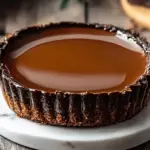The rich, velvety roux, the bold Cajun spices, and tender shrimp all simmer together in this Louisiana-style Shrimp Étouffée to create a soul-satisfying dish that bursts with flavor. Every spoonful is steeped in tradition, delivering comfort with a slight kick of heat and the warmth of Creole heritage.
Whether you’re feeding a hungry family on a weeknight or impressing guests with your Southern flair, this Shrimp Étouffée brings New Orleans straight to your dinner table. It’s surprisingly easy, irresistibly hearty, and even better the next day. Just don’t forget the fluffy rice to soak up every last drop!
Full Recipe:
Ingredients:
-
1½ lbs shrimp (peeled and deveined)
-
1 tablespoon Cajun seasoning
-
1 tablespoon olive oil
-
⅔ stick unsalted butter (about 5 tbsp + 1 tsp)
-
⅓ cup all-purpose flour
-
2 cups chicken broth (or seafood stock for more flavor)
-
1 medium onion, diced
-
½ cup green bell pepper, diced
-
1-2 stalks celery, chopped
-
3 tsp garlic, minced
-
1 tsp dried thyme
-
2 bay leaves
-
1 tbsp Worcestershire sauce
-
1 cup fresh tomato, diced
-
1 tbsp Creole or Cajun seasoning
-
Salt and pepper to taste
-
¼ cup green onions, thinly sliced
-
¼ cup parsley, chopped
-
½ lemon, juiced
Directions:
-
Mix Spices: Combine paprika, thyme, oregano, cayenne, garlic powder, onion powder, white pepper, and black pepper in a small bowl.
-
Prep the Shrimp: Pat shrimp dry and toss with Cajun seasoning and a pinch of salt.
-
Sear Shrimp: In a hot skillet with olive oil, sear shrimp for 1 minute per side until just pink. Remove and set aside.
-
Build Broth: Drain shrimp juices and combine with chicken stock to reach 2 cups.
-
Sauté Veggies: In the same skillet, melt butter. Add onion, bell pepper, and celery. Sauté until soft. Add garlic and remaining Cajun seasoning.
-
Make the Roux: Stir in flour and cook for 2-3 minutes. Add diced tomatoes and stir until slightly browned.
-
Add Broth: Gradually whisk in the stock mixture until smooth. Bring to a simmer and cook until slightly thickened.
-
Final Seasoning: Add Worcestershire sauce, lemon juice, salt, and pepper.
-
Reunite with Shrimp: Return shrimp to the sauce and warm through for 1-2 minutes.
-
Garnish & Serve: Top with parsley and green onions. Serve over warm rice.
Prep Time: 10 minutes | Cooking Time: 30 minutes | Total Time: 40 minutes
Kcal: 260 kcal | Servings: 4 servings
Shrimp Étouffée: A Taste of Louisiana’s Soul on a Plate
When it comes to iconic Southern dishes that embody comfort, tradition, and bold flavor, Shrimp Étouffée sits high on the list. Hailing from the heart of Louisiana, this dish is steeped in culture and culinary heritage, blending French cooking techniques with Creole and Cajun spice for a uniquely American masterpiece.
Shrimp Étouffée (pronounced “ay-too-fay”) is more than just a shrimp stew it’s an experience. It combines plump shrimp with a richly flavored sauce built on a roux and the “Holy Trinity” of Southern cooking: onions, celery, and bell pepper. This luscious sauce is ladled over a bed of fluffy rice, soaking into every grain with savory, spicy goodness.
But what makes Shrimp Étouffée truly stand out? Let’s dive deep into the origins, variations, and techniques that make this dish a star in kitchens across the South and increasingly, across the globe.
A Brief History of Étouffée
The term “étouffée” comes from the French word étouffer, meaning “to smother.” And that’s exactly what this dish does: it smothers shrimp in a velvety, flavorful sauce. Étouffée has its roots in the Cajun and Creole communities of Louisiana, each of which adds its own twist to the dish.
Creole-style étouffée, which is popular in New Orleans, typically incorporates tomatoes and leans more heavily on herbs and spices. Cajun-style, by contrast, usually skips the tomatoes and relies on a darker roux and bolder seasoning. Both versions are built on a foundation of French culinary technique (the roux) and seasoned to perfection with spices like cayenne, paprika, thyme, and bay leaf.
Though crawfish étouffée was the original variation, shrimp became a widely loved and more accessible substitute, especially outside of crawfish season. It’s become a beloved weeknight dinner and Sunday special across Southern households and for good reason.
Why the Roux Matters
At the heart of any good étouffée is the roux a mixture of flour and fat cooked together until it reaches the desired color. The roux is what transforms this dish from a simple stew into something rich, complex, and soul-satisfying.
There are different levels of roux, from pale blonde to chocolate brown, and each imparts a different flavor. For Shrimp Étouffée, most cooks opt for a medium to medium-dark roux. It takes a bit of patience roux must be stirred constantly to avoid burning but the result is a toasty, nutty base that gives the sauce its unmistakable depth.
Unlike gumbo, which often calls for a very dark roux, étouffée benefits from a slightly lighter one, allowing the other ingredients particularly the shrimp to shine through.
Tips for Making an Authentic Shrimp Étouffée
Although the recipe is simple in theory, mastering Shrimp Étouffée requires attention to a few key details:
1. Use Fresh or Well-Prepared Shrimp
Fresh shrimp are ideal, but frozen shrimp can be used as long as they’re peeled, deveined, and patted dry before cooking. A quick sear adds flavor and ensures they don’t become rubbery when added to the sauce later.
2. Build Layers of Flavor
Cooking the vegetables in the roux helps infuse the base with aromatics. Don’t rush this step. Let the onions, celery, and bell pepper become tender and slightly caramelized for the best flavor.
3. Don’t Overcook the Shrimp
This is a common mistake. Shrimp only need a minute or two in the sauce to warm through. They should be added at the end, just before serving, to avoid a chewy texture.
4. Season Gradually
Taste as you go. Cajun and Creole seasonings often contain salt, so be careful not to oversalt. A splash of Worcestershire and lemon juice at the end can also brighten the dish beautifully.
Variations and Customizations
One of the great things about Shrimp Étouffée is how customizable it is. It’s a forgiving dish that welcomes creativity without compromising authenticity.
Seafood Swaps
While shrimp is the star in this version, you can substitute crawfish, crab, lobster, or a mix of shellfish. Crawfish étouffée is especially popular in Louisiana and is considered the original.
Vegetarian or Vegan Twist
Yes, you can make a plant-based étouffée! Use a mushroom or vegetable broth for the base and replace the shrimp with hearty vegetables like mushrooms, eggplant, okra, or jackfruit. A roux made with olive oil or vegan butter keeps it dairy-free.
Low-Carb or Paleo
For those watching carbs, serve the étouffée over cauliflower rice. Paleo versions often swap traditional flour for arrowroot or almond flour and use ghee in place of butter.
Spice Level
Control the heat with your seasoning. Some prefer a mild kick, while others want full Louisiana fire. Add hot sauce or cayenne at the end so you can adjust per serving.
What to Serve with Shrimp Étouffée
This dish is hearty enough to stand alone, but a few sides can turn it into a true Southern feast.
-
White Rice: The traditional companion, soaking up the sauce and balancing the spice.
-
Cornbread: Adds a sweet and crumbly contrast to the rich stew.
-
Fried Okra: A crunchy, Southern classic.
-
Collard Greens or Kale: Adds bitterness and depth to your meal.
-
Simple Green Salad: A refreshing counterpoint to the heavy sauce.
-
Garlic Bread or Crusty French Bread: Perfect for sopping up every last drop.
Leftovers and Meal Prep
One of the best things about Shrimp Étouffée? It tastes even better the next day. The flavors continue to develop overnight, making it a fantastic make-ahead meal. Just store it in the fridge in an airtight container and reheat gently on the stove.
If you plan to freeze it, consider leaving out the shrimp and adding them fresh when reheating to avoid overcooking.
A Dish Worth Mastering
Shrimp Étouffée isn’t just food it’s culture, comfort, and history in a bowl. Whether you’re new to Cajun and Creole cuisine or a seasoned Southern cook, this dish is worth adding to your repertoire.
From the first spoonful, it offers something special a warm, smoky sauce with the gentle heat of spices, the brightness of herbs, and the satisfying bite of perfectly cooked shrimp. It invites you to slow down, savor each bite, and maybe even reach for seconds.
Whether you’re making it for a weeknight dinner or a festive weekend gathering, Shrimp Étouffée is guaranteed to impress. And once you’ve mastered the roux and found your perfect spice blend, you’ll want to make it again and again.
Conclusion:
Shrimp Étouffée is a true celebration of Louisiana’s culinary legacy a dish that bridges cultures and generations through its bold flavors and heartfelt preparation. With just a bit of care and creativity, it becomes more than a meal; it becomes a memory.
So, heat up your skillet, prep your Holy Trinity, and get ready to smother those shrimp in love. Étouffée isn’t just what’s for dinner it’s an experience worth savoring.






